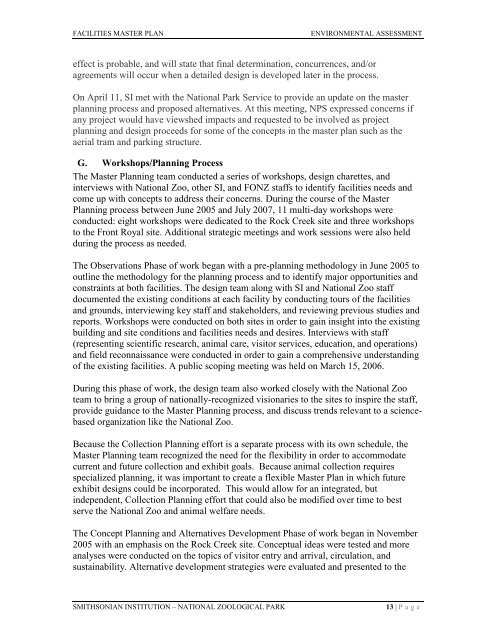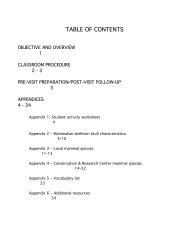facilities renewal master plan - National Zoo - Smithsonian Institution
facilities renewal master plan - National Zoo - Smithsonian Institution
facilities renewal master plan - National Zoo - Smithsonian Institution
Create successful ePaper yourself
Turn your PDF publications into a flip-book with our unique Google optimized e-Paper software.
FACILITIES MASTER PLAN ENVIRONMENTAL ASSESSMENT<br />
effect is probable, and will state that final determination, concurrences, and/or<br />
agreements will occur when a detailed design is developed later in the process.<br />
On April 11, SI met with the <strong>National</strong> Park Service to provide an update on the <strong>master</strong><br />
<strong>plan</strong>ning process and proposed alternatives. At this meeting, NPS expressed concerns if<br />
any project would have viewshed impacts and requested to be involved as project<br />
<strong>plan</strong>ning and design proceeds for some of the concepts in the <strong>master</strong> <strong>plan</strong> such as the<br />
aerial tram and parking structure.<br />
G. Workshops/Planning Process<br />
The Master Planning team conducted a series of workshops, design charettes, and<br />
interviews with <strong>National</strong> <strong>Zoo</strong>, other SI, and FONZ staffs to identify <strong>facilities</strong> needs and<br />
come up with concepts to address their concerns. During the course of the Master<br />
Planning process between June 2005 and July 2007, 11 multi-day workshops were<br />
conducted: eight workshops were dedicated to the Rock Creek site and three workshops<br />
to the Front Royal site. Additional strategic meetings and work sessions were also held<br />
during the process as needed.<br />
The Observations Phase of work began with a pre-<strong>plan</strong>ning methodology in June 2005 to<br />
outline the methodology for the <strong>plan</strong>ning process and to identify major opportunities and<br />
constraints at both <strong>facilities</strong>. The design team along with SI and <strong>National</strong> <strong>Zoo</strong> staff<br />
documented the existing conditions at each facility by conducting tours of the <strong>facilities</strong><br />
and grounds, interviewing key staff and stakeholders, and reviewing previous studies and<br />
reports. Workshops were conducted on both sites in order to gain insight into the existing<br />
building and site conditions and <strong>facilities</strong> needs and desires. Interviews with staff<br />
(representing scientific research, animal care, visitor services, education, and operations)<br />
and field reconnaissance were conducted in order to gain a comprehensive understanding<br />
of the existing <strong>facilities</strong>. A public scoping meeting was held on March 15, 2006.<br />
During this phase of work, the design team also worked closely with the <strong>National</strong> <strong>Zoo</strong><br />
team to bring a group of nationally-recognized visionaries to the sites to inspire the staff,<br />
provide guidance to the Master Planning process, and discuss trends relevant to a sciencebased<br />
organization like the <strong>National</strong> <strong>Zoo</strong>.<br />
Because the Collection Planning effort is a separate process with its own schedule, the<br />
Master Planning team recognized the need for the flexibility in order to accommodate<br />
current and future collection and exhibit goals. Because animal collection requires<br />
specialized <strong>plan</strong>ning, it was important to create a flexible Master Plan in which future<br />
exhibit designs could be incorporated. This would allow for an integrated, but<br />
independent, Collection Planning effort that could also be modified over time to best<br />
serve the <strong>National</strong> <strong>Zoo</strong> and animal welfare needs.<br />
The Concept Planning and Alternatives Development Phase of work began in November<br />
2005 with an emphasis on the Rock Creek site. Conceptual ideas were tested and more<br />
analyses were conducted on the topics of visitor entry and arrival, circulation, and<br />
sustainability. Alternative development strategies were evaluated and presented to the<br />
SMITHSONIAN INSTITUTION – NATIONAL ZOOLOGICAL PARK 13 | P a g e

















